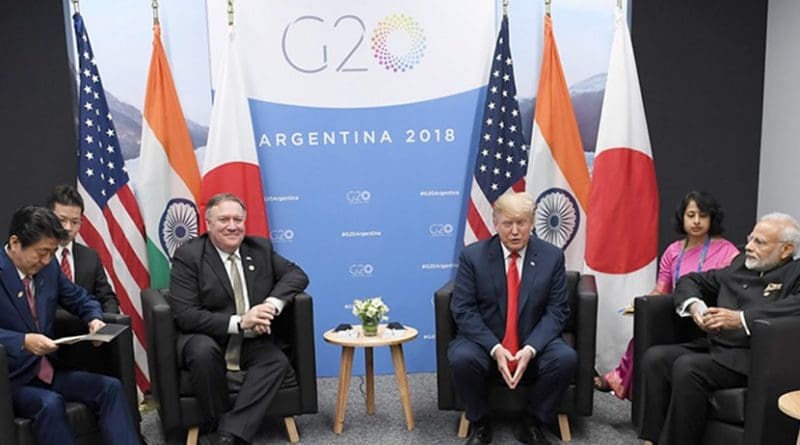India Must Do A China To Avoid A Trade War With The US – Analysis
By Observer Research Foundation
A pragmatic problem solving approach to the India-US trade spat is likely to yield New Delhi much greater dividends than an openly confrontational one.
By Harsh V. Pant
The US-China trade war seems to be coming to an end as reports of a possible deal have gathered momentum in recent days. US secretary of state Mike Pompeo has expressed optimism that trade talks with China aimed at ending tariffs on hundreds of billions of dollars worth of products will be successful. Treasury secretary Steven Munchin has also suggested that the two sides were getting closer to a trade deal and White House economic adviser Larry Kudlow has underlined that “the progress (between the two countries) has been terrific”. Negotiations are reportedly in the last leg as the two sides plan a summit for the end of March at Mar-a-Lago, US President Donald Trump’s Florida resort. Despite the hype, it still remains to be seen if the US-China trade deal actually goes through.
If a deal is reached, the US would roll back tariffs on at least $200 billion in Chinese goods while China would reduce industry-specific levies like those on autos. Meanwhile, China is also gearing up to pass a new foreign investment law to provide a level-playing field to global investors with legal safeguards on Intellectual Property Rights (IPR) and technology transfer, thereby meeting a key demand of the Trump administration. This draft foreign investment law will be submitted to the National People’s Congress of China for review and is likely to be put to vote soon.
China has also offered to increase purchases of US goods by $1.2 trillion over six years, benefiting agriculture and energy. That would allay Trump’s concerns about the chronic US trade deficit with China. However, Beijing is insisting that removing levies on $200 billion of Chinese goods quickly is necessary to finalize any trade deal.
The two countries plan to set up a mechanism to hold regular consultations at various levels of the US and Chinese governments to address trade irritants. According to US trade representative Robert Lighthizer, the US will respond with “proportional” and “unilateral” action like tariffs, if talks fail to achieve the desired result. The Trump administration is still debating the wisdom of lifting duties at the start of a deal because keeping some tariffs in place would allow the US to maintain leverage.
The US and China, the two largest global economies, are locked in a trade war since Trump imposed heavy tariffs on imported steel and aluminum items from China in March last year, which led to China imposing tit-for-tat tariffs on billions of dollars worth of American imports.
China finds itself in a tough spot. It has lowered its goal for economic growth and announced a major tax cut, amid a growing debt crisis and trade conflict with the US. Its 2019 gross domestic product (GDP) growth target of 6%-6.5% is the slowest pace of economic growth in almost three decades. Last month, Chinese exports plunged 21% from a year earlier, with the value of goods shipped to the US falling much more sharply than for other major markets.
And even if trade tensions ease with the US, the Chinese economy continues to face debt risks and slowing of domestic consumption growth. It is, therefore, not surprising that China is hurrying to resolve the trade standoff with the US. Yet, Chinese President Xi Jinping would have to be careful of the optics of signing a deal with Trump, which will be proclaimed as a big win by the US president. Losing face vis-à-vis Trump can be dangerous for Xi back home.
For Trump, a US-China trade deal will be seen as a victory after a string of domestic defeats and tightening of screws on the Russia investigation. If a deal is reached with China, then Trump would claim victory in the negotiations, allowing him to save face politically after his humiliating climb-down on his pet project of wall funding. Meanwhile, the US economy is also facing negative headwinds.
Though a US-China trade deal would be good news for the global economy facing crises on multiple fronts, it is not readily evident if the structural issues that bedevil US-China trade relations will disappear anytime soon, even with a possible deal. However, the Chinese are essentially pragmatists and have recognized the need to reach a modus vivendi with Trump. Much before Trump made “transactionalism” popular, Beijing’s approach was transactional in more ways than one.
As Trump turns his attention to India on trade, it remains to be seen if New Delhi can also imbibe a bit of transactionalism in its approach. Trump has made it clear that he intends to end India’s preferential trade treatment under a programme that allows $5.6 billion worth of Indian exports to enter the US duty free, asserting that New Delhi has failed to assure America of “equitable and reasonable” access to its markets.
India is the world’s largest beneficiary of that scheme and its end would be the strongest punitive action against India since Trump took office in 2017.
Though India has asserted that this move is not likely to have a significant impact on bilateral trade, it does add a note of strain in an otherwise robust bilateral strategic partnership.
Trump notwithstanding, the strategic logic of Indo-US engagement is quite clear to policy makers on both sides. Given that these are election times, the temptation in India will be to play to the gallery. However, as the Chinese have shown, quiet diplomatic engagement might be the best way forward for India.
A pragmatic problem solving approach is likely to yield New Delhi much greater dividends than an openly confrontational one.
This article originally appeared in Livemint.

